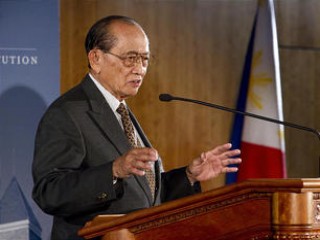
Fidel Valdez Ramos biography
Date of birth : 1928-03-18
Date of death : -
Birthplace : Lingayen, Pangasinan, Philippines
Nationality : Filipino
Category : Politics
Last modified : 2011-05-04
Credited as : Politician, former President of Philippines, FVR
Fidel Valdez Ramos was inaugurated president of the Philippines in June 1992. He had the mandate to continue the democratic reforms gained by the country during Corazon Aquino's peaceful people-power revolution of 1986.
The eighth president of the postwar Philippine Republic, Fidel Valdez Ramos was known as a hero of the 1986 people-power revolution, the bloodless coup that ousted dictator Ferdinand Marcos. Corazon Aquino, the widow of Marcos' assassinated archenemy, was installed in the presidency at that time.
People power was Ramos' idea of how to fight the weapons of the Marcos regime when the dictator, losing confidence in Constabulary Chief Fidel Ramos and his defense minister, Juan Ponce Enrile, set out to destroy them. Ramos asked Jaime Cardinal Sin to send people to protect their fortress, the Constabulary Camp at EDSA (Epifanio de los Santos Avenue). Cardinal Sin appealed to the people by radio, and millions of people surrounded the camp to protect Ramos, Enrile, and the soldiers who joined them. The people at EDSA thwarted tanks and armored vehicles, and in four days in 1986 caused the flight to Hawaii of Marcos and his family. Corazon C. Aquino, who may have won a controversial election against Marcos weeks before, became president, and democracy was restored after 20 years of autocratic rule.
After the EDSA victory, "Eddie" Ramos, who had been a soldier all his adult life, served President Aquino as chief of staff of the armed forces of the Philippines and later as secretary of national defense. During the six years of Aquino's administration Ramos defeated seven coup attempts, two of them serious. His successful maneuvers against the coups earned for him the trust and confidence of President Aquino, who, towards the end of her term, openly supported him to be her successor to the presidency.
Ramos won in the May 1992 elections over six other candidates, garnering only 24 percent of the votes but winning 800,000 votes more than his closest rival. Within his first year in office he was able to win over to his side a majority of the people, who developed confidence in his government. He gained their support through a strategy of reconciliation and a strong hands-on leadership. The restoration of democracy was a long, difficult task, while at the same time Ramos had to attend to major economic and social problems that had grown during the Marcos years.
Under Ramos' presidential leadership, the Phillipines became known as the "Asian Tiger." He was widely credited for reviving the country's economy, and it grew at a brisk pace of seven percent annually through the mid-1990s. Admirers of his businesslike approach called him "Steady Eddie," and many foreign investors poured money into the country. He also ended crippling regulation of the telecommunications, banking, insurance, shipping and oil
industries. Meanwhile, Ramos quieted long-standing troubles with Communist guerrillas, right-wing military offices and Muslim separatists, making life in the Phillippines more stable than it had been in decades.
Ramos grew up with a sense of government. His father served the Philippine Republic in the 1960s as secretary of national defense. He also came to the job of president educationally prepared, with a degree from the United States Military Academy at West Point and an engineering degree from the University of Illinois at Champaign-Urbana. In a country where law is the typical training for the presidency, Ramos came with atypical qualifications. He had only a short stint as a member of a political party, the ruling LDP (Lakas ng Demokratikong Pilipino or Fight of Democratic Filipinos), which then spurned him as their nominee for the presidency. However, Ramos ascended to the highest post in the land via a new party, the Lakas ng EDSA (Strength of EDSA) or NUCD (National Union of Christian Democrats). Lastly, in a country that was 85 percent Catholic, Ramos was the first Protestant president. He was married and the father of five daughters.
The unusual people-power revolution at EDSA enabled an unusual person like Ramos to lead the Philippines. In December 1996, Ramos had surgery to remove a life-threatening blockage in the artery to his brain, but he recovered. Near the end of his term, supporters advocated changing the country's young Constitution to allow him to run for a second six-year term in 1998. They wanted to continue his steady leadership and the Phillippine economic rennaissance, arguing that no other candidate could fill his shoes as president. However, many others, including former president Aquino and the nation's 100 Roman Catholic bishops, strongly objected. They urged respect for the Constitution, warning any such change could plunge the country back to a Marcos-like dictatorship. Ramos, ever low-key, did not reveal his plans, but told reporters "I would not want the policies, the momentum, the tremendous progress we have achieved wasted."

















